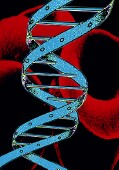
WEDNESDAY, June 15 (HealthDay News) — Twins with a rare disorder that left one of them unable to walk are now playing soccer and running track, thanks in part to cutting-edge technology known as whole-genome sequencing that enabled physicians to better treat the disorder.
Soon after Alexis and Noah Beery were born it was obvious to their parents, Joe and Retta, that the twins were different from their older brother, Zach. They cried nonstop, vomited frequently, had poor muscle tone and missed their developmental milestones.
Looking for answers, Retta took them to dozens of specialists who did blood draws and brain scans. Eventually, physicians diagnosed the twins with cerebral palsy, which can be caused by a lack of oxygen in the womb that injures the brain, leading to movement difficulties, muscle weakness and tight, constricted muscles or joints.
Despite various therapies, at age 5, Alexis’s condition suddenly worsened, something Retta knew wasn’t typical of cerebral palsy from the countless hours she’d spent researching her children’s condition. Alexis was having difficulty swallowing, could hardly sit up on her own and was wasting away.
Desperate, Retta again went looking for answers.
During her hunt, she came across an old newspaper article about a rare disorder, dopa-responsive dystonia, which is caused by a deficiency of the brain neurotransmitter dopamine and is often misdiagnosed as cerebral palsy. The symptoms matched her daughter’s: tremors, muscle rigidity and difficulty walking, especially later in the day.
“Everything in me knew this is what Alexis had,” Retta said.
And there was good news: Dopa-responsive dystonia is treatable.
The Beerys, who were living in Phoenix, Arizona at the time, found a physician in Michigan who was looking for people with dopa-responsive dystonia who had been misdiagnosed. He prescribed levodopa (L-Dopa), the same medication used to treat people with Parkinson’s, another disease in which dopamine deficiency also plays a crucial role.
That night, Alexis slept through the night for the first time in her life. Within 24 hours, Alexis, whose disease had grown more severe more quickly than her brother’s, was able to walk on her own for the first time in months.
“We knew we were witnessing a miracle,” Retta said.
Soon after, Noah’s condition also began to worsen and he too saw marked improvement on L-Dopa.
All was going well until about six years ago when Alexis developed a severe, nagging cough and breathing difficulties. Doctors again were stumped. Asthma medications didn’t work. After Alexis passed out from lack of oxygen, she had to give up sports. The family was giving her epinephrine in a nebulizer multiple times daily to keep her breathing.
By this point, the family had moved to San Diego and Joe Beery was working for Life Technologies Corp., based in Carlsbad, Calif., which makes gene sequencing technology used by researchers at Baylor Human Genome Sequencing Center. The Beery’s wondered if whole-gene sequencing, which scans the entire genome for mutations, would yield answers about what was wrong with Alexis.
When the researchers at Baylor sequenced the twins’ genome, they found that the twins had a particular subtype of dopa-responsive dystonia that prior research has shown isn’t due to just a dopamine deficiency, but also to a serotonin deficiency, another key neurotransmitter.
Only about 3 percent of people with dopa-responsive dystonia have the mutation, said lead study author Matthew Bainbridge, a post-doctoral fellow at Baylor, whose research was published in the June 15 issue of Science Translational Medicine.
When the family got the results in January, physicians put the twins on a supplement, 5-HTP, to boost their serotonin levels, and within weeks Alexis’s cough subsided. Noah also saw an improvement in his fine-motor skills and focus at school, something he’d been struggling with.
Experts say the findings are among the first time that whole-genome sequencing has revealed information that physicians could immediately use to improve treatment — something that may herald a new era of medicine.
“Up until this point, a lot of gene sequencing is basic science. We can determine which gene is involved, but the next step, developing the drug, isn’t there yet,” Bainbridge said. “This is what makes this study fairly unique in that it was medically actionable.”
Other experts agree there is more to come. It was only in 2003 that the first whole-genome sequencing was completed — the Human Genome Project, which was enormously expensive, according to Stephen Kingsmore, director of the Center for Pediatric Genomic Medicine at Children’s Mercy Hospital in Kansas City.
Subsequent sequencings cost between $1 million and $2 million. Today, the cost is about $10,000, said Kingsmore, who wrote an accompanying editorial.
Even newer, more targeted and less expensive technologies have the potential to bring down the cost to $5,000 or even lower, Kingsmore said, although as of now, those are not available outside of research institutions.
But if such lower-cost sequencing became available, it could lead to more accurate, faster diagnosis of the nearly 3,000 Mendelian diseases, or diseases caused by a mutation on a single gene, such as sickle cell anemia or cystic fibrosis, for which research has identified a known genetic cause.
Today, families often spend many stressful months and years visiting doctors and undergoing tests to figure out what’s going on with their child.
Kingsmore said that for some of these diseases, whole-gene sequencing might help solve the “bottleneck” in terms of the inability to make a diagnosis — or a diagnosis that takes so long that the child is very late in the disease before physicians figure out what is wrong. “If we can make an early diagnosis, that will breathe fresh life into looking for new treatments,” Kingsmore said.
Today, Retta Beery is like many other moms. She spends afternoons shuttling her now 13-year-old twins to soccer, volleyball and track practice. But she may have a different take on that role.
“Every time they do anything, we continue to be in awe,” she said. We don’t take it for granted. We know how incredible it is they are able to function and to do the things that they are doing. We want them to know this is their testimony, and what has really shaped our whole family in so many ways.”
More information
We Move has more on dopa-responsive dystonia.

